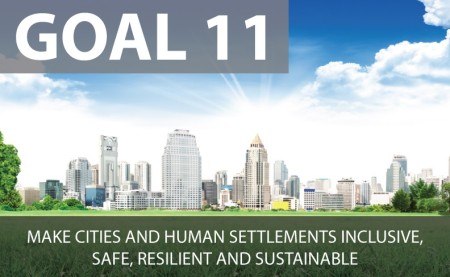Who doesn’t want to live in a comfortable home, enjoy a safe working environment and be part of a community that contributes to your quality of life? It sounds like a simple ask, but for so many in the world it is a distant dream.
The challenge behind SDG number 11: make cities and human settlements inclusive, safe and sustainable, is that it impacts on a multitude of different levels. Andrew Wilson explores how to truly make progress in this respect – the long list of requirements will need to include:
- ensuring access for all to safe and affordable housing
- meeting people’s needs for basic services including energy and water
- developing sustainable public transport systems
- creating a built environment that can minimize the impacts of natural disasters
- reducing the adverse environmental impact of cities by investing in renewable energy, managing scarce resources, and improving waste and recycling systems.
The good news is that, if we are able to effect positive change, the benefits will potentially be felt by the majority of the world’s population. Just consider some of the fundamental facts and figures about the importance of cities today.
- According to research from the London School of Economics, cities currently make up 2% of the world’s surface area – but produce 70% of the global economic output.
- Other sources suggest that cities and urban areas will account for most of the world’s net population growth over the next two decades, with 1.4 million people being added to urban areas each week. This is the equivalent to the population of cities like Leeds in the UK or San Diego in the US.
- To put this another way, almost half of the world’s population currently lives in cities, and by 2050 that is projected to increase to over 70%.
Given this data, it is not surprising that sustainable urban development is of critical importance to the future of the planet. According to The Intergovernmental Panel on Climate Change (IPCC), cities currently account for around 70% of global greenhouse gas emissions and 70% of global energy consumption.

Other research suggests that in OECD countries alone, the built environment is responsible for:
- 30% of raw material use
- between 25-40% of total energy use
- 30-40% of greenhouse gas emissions
- 30-40% of solid waste generation.
As such, positive action on the built environment is of paramount concern. We already know that properly planned building developments and urbanisation can improve land use, reduce resource consumption, decrease congestion and improve productivity – all of which has a beneficial impact on people, communities, local and national economies. In addition, healthy and sustainable buildings can contribute significantly to social well-being. Efforts towards regeneration in cities can break down exclusions and restore community spirit.
However, this is not simply a task for urban planners, architects, property developers and the construction industry. Businesses across a wide array of sectors can contribute to a collective effort to make cities more sustainable. It is in our shared interest that all of us – as individuals, businesses, opinion formers and citizens – do our bit to contribute to the creation of sustainable cities.
Around the world there are innovative ideas providing a glimpse of what can be achieved. Some futuristic examples, such as Songdo in South Korea and Masdar in Abu Dhabi, are already being built and developed. The low-carbon development of Masdar City is designed to reduce environmental impacts and includes a 10-megawatt solar photovoltaic plant together with an array of building-mounted solar panels to provide for as much of the electricity use as possible.
But the movement towards sustainable cities can also draw inspiration from more well-established examples. The city of Curitiba in Brazil has long been a reference point for sustainability. It opened the world’s first bus rapid transit system which encouraged a huge shift from car travel to public transport. Compared to eight other Brazilian cities of its size, Curitiba uses about 30% less fuel per person resulting in one of the country’s lowest rates of ambient air pollution. In another initiative, the favelas on the outskirts of the city are kept clean by encouraging people to bring their rubbish to collection points where the city authorities exchange sacks of food or bus tickets in return for waste.
Wherever we draw our inspiration, it is clear that one of the key trends in sustainable cities will be the massive rise in technology – in the future everything in a city, from the electricity grid, to the sewer pipes, to roads, buildings and vehicles will be connected to the network.
Communities will control small scale energy generation and management systems, powered by renewable sources. Self-driving transits systems and shared electric vehicles will allow you to get from place-to-place without the need for private transport. More sophisticated connectivity will encourage a sharing economy to help people swap goods, skills and services.
However, the challenge of sustainable cities is not simply about developing new technological solutions to long-standing problems. Rather, success in this sphere will only be achieved by balancing the demands of social and economic development with careful environmental management and innovative urban governance.
The solution to achieving SDG 11 will be found in understanding the links between all of these aspects and managing their convergence. Businesses across a wide range of sectors will have a pivotal role to play in creating truly systemic approaches to the issues.
You can view Corporate Citizenship’s full SDGs 2015 blog series here.

